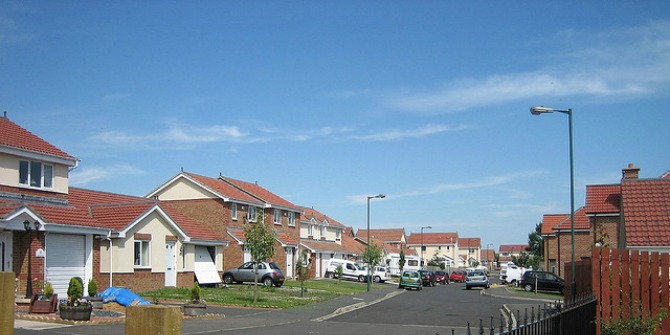
Between the slum clearances of the early twentieth century and debates about the post-Olympic city, the drive to regenerate London has intensified. Yet today, with a focus on increasing land values, regeneration schemes purporting to foster diverse and creative new neighbourhoods typically displace precisely the qualities, activities and communities they claim to support. In Remaking London, Ben Campkin aims to provide a lucid and stimulating historical account of urban regeneration, exploring how decline and renewal have been imagined and realised at different scales. Reviewed by David Madden.

Regeneration and decay are central keywords for understanding contemporary cities. The fact that both terms are essentially impervious to definition without engaging with the intense politics of place that animates their usage doesn’t seem to dampen their popularity. Given the frequency with which rhetoric about decline and regeneration appears on the lips and in the press releases of mayors, councillors, real estate developers, architects and planners, any analysis of urban development today needs to grapple with these two slippery signifiers.
As Ben Campkin shows in his new book Remaking London: Decline and Regeneration in Urban Culture, discourses of urban decay and practices of urban regeneration have a long and complex history. Campkin, director of the Urban Laboratory at UCL and senior lecturer in the Bartlett School of Architecture, examines some of the major moments, from the twentieth century through today, when London was simultaneously diagnosed, destroyed, reimagined, and remade. In doing so, he offers a skillful historical account of the intertwined aesthetic, moral, social, and political projects that have been pursued in the name of regeneration. And because regeneration is indeed, as Campkin writes, ‘a pervasive metaphor for urban change in London’, the book serves as a crucial intervention into contemporary debates about urbanism.
The book uses the tools of cultural and architectural history, and scores of photographs and images, to examine ‘the imaginaries of urban regeneration and degradation — those representations that have an active role in shaping the experience, understanding and material conditions of contested places’. This concept of ‘place imaginaries’ draws on Lacan and Castoriadis, and echoes of Guy Debord can be heard in the book’s invocations of the ‘spectacle’ of urban degradation and redevelopment. The focus on representations allows Remaking London to remain agnostic regarding the ontological status of its object of study. Campkin doesn’t go so far as to debunk the very notions of decline and regeneration altogether. Rather, he adopts a perspective that mixes politics and psychoanalysis, arguing that the will to improve is a symptomatic response to the anxieties caused by the spectacle of abjection and decay — a response which in the twentieth century coincided with various episodes of urban renewal but which today dovetails with the political, economic, and cultural agendas of neoliberal urbanisation.
Chapter-length case studies range widely but never lose focus. A study of pest infestation in 1920s Somers Town, near present-day Euston Road, examines how ‘unwanted urban nature’ contributed to the spectacle of unclean life in an interwar ‘slum’ — a perspective which was used to legitimise the area’s destruction. Bert Hardy’s late 1940s photographs for Picture Post are used to show how documentary photography contributed to the sadly on-going history of portraying the Elephant and Castle as a ‘ruined’, ‘dysfunctional’ community. An analysis of the redevelopment of King’s Cross from 1987 onwards demonstrates how real estate actors sought both to expunge and to exploit the area’s notoriety and blight. Readings of Dirty House, a home and studio built in Shoreditch in 2002, designed by David Adjaye for Tim Noble and Sue Webster, and of Buried (2006), a collection of photographs of pre-Olympian Hackney Wick taken by Stephen Gill, provide an opportunity for Campkin to analyse the aestheticisation of grime and ruin in the contemporary city.
Probably the best chapter in the book is ‘Sink Estate Spectacle’, an analysis of the building of the Heygate and Aylesbury estates and their subsequent stigmatisation by publicity-seeking politicians and urbanists. Campkin acknowledges that financial limitations did mean that some compromises were made in the estates’ original construction. But he explains convincingly that the actual problems that the estates faced had far more to do with Southwark’s financial mismanagement and maintenance failures and never matched the cartoon conjured by conservative urbanists like Oscar Newman and Alice Coleman. Yet Newman, Coleman, and a parade of politicians including Neil Kinnock, Tony Blair, and Michael Howard have all used Heygate and Aylesbury as sites for grandstanding about housing design, criminality, social breakdown, and ‘the underclass’ – rhetoric that was used to justify privatization, evictions, and cutbacks that continue to this day. Reflecting on this history, Campkin notes, ‘When we examine the uses of the estates in architectural and political discourses we see that these representations of decline are far from neutral; rather, they result from specific ideological positions… They also conceal, rather than clarify, the important factors underlying the estates’ material decline’. This analysis can help to highlight the ways in which barely updated versions of the same old anti-poor discourses are still being peddled today by an unreconstructed stigmatisation machine made up of politicians, real estate interests, and their allies in architecture and urban design.

All too often with regeneration schemes, ‘the worst consequences of certain forms of neoliberal urbanisation are concealed behind a façade of social improvement’. Ultimately, decline and regeneration appear to be ubiquitous and influential but nonetheless seriously misleading ways of understanding suffering and prosperity in the city. This is partly because they are inherently superficial judgements that ignore deeper and more complex determinants of urban fortunes. It’s also because decline and regeneration are the kinds of appraisals that as a rule are only made by outsiders and experts who studiously avoid listening to the voices of the poor themselves.
But given these limitations, what explains the persistent usage of these concepts over the decades by progressives, modernists and now neoliberals? The book doesn’t venture to explain why regeneration and decline have been and continue to be so central to the lexicon of urban development. Campkin observes that ‘degradation has typically been conceptualised as existing outside of capitalist urbanisation… rather than fundamental to its process of “creative destruction” and its attendant discourses’. Is it that decline is a way to account for deprivation without talking about power and politics? Has regeneration been consistently so useful as a ruling idea that various ruling groups have worked to continuously reproduce its prestige as a way to maintain their own authority? Campkin’s emphasis on description and analysis over grand synthesis tends to serve him well, but an explanation for regeneration’s eternal return would have been helpful.
That said, overall Remaking London is a well-researched and important study. And given the sheer number of self-declared regeneration projects proliferating throughout London — Campkin notes that a 2010 council-produced film declared with typical understatement that ‘A regeneration supernova is currently exploding across Newham’—it is certainly timely. He writes, ‘Now, more than ever before, there is an acute tension between market-led approaches to regeneration that fragment the city they set out to cohere, and democratic processes for the achievement of community-led collective visions of urban improvement’. Accomplishing the latter requires a critical analysis of the former. Regeneration has long been changing the city, in various ways; the point today is to understand it.
—————————————
David Madden is Assistant Professor in the Department of Sociology at the London School of Economics. He also teaches in the Cities Programme. He can be found on Twitter @davidjmadden. Read more reviews by David.







The book and this review further underline the enduring, pervasive and continuing failure of urban regeneration policy and practice across the UK on the matter of community engagement – a failure even more pronounced on the unctuously termed ‘community empowerment’ front.
In my own submission in response to the Scottish Government’s consultation on their intended new community regeneration strategy in 201, I laid out the extensive bibliography across the UK over several decades on these failures. I also pointed out that the Scottish Government’s own consultation paper was virtually silent on these failures. Perhaps it’s instructive that in the Scottish Government’s subsequent paper subsequent to the consultation there was still no reference to this history of failure?